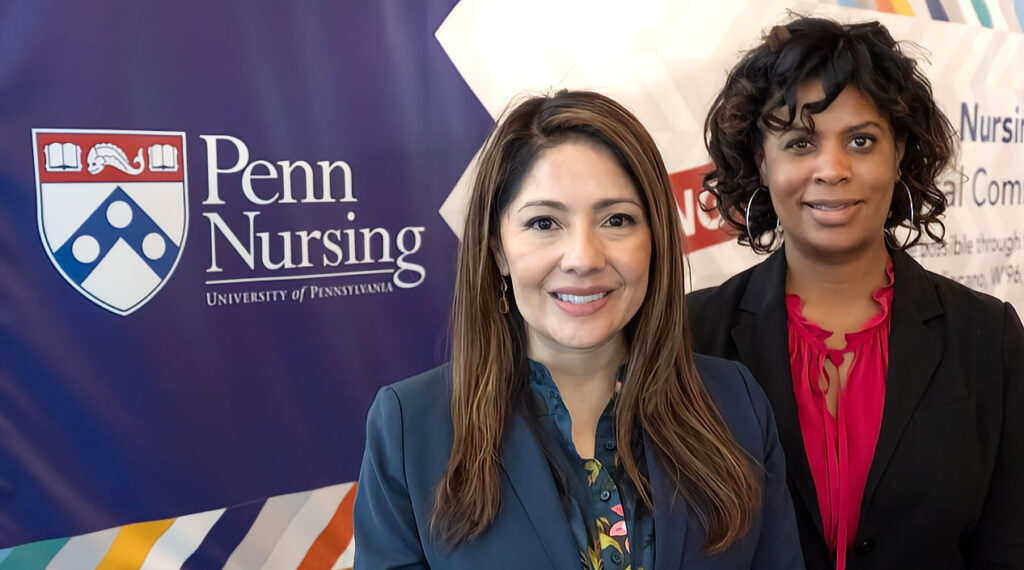
HIV is Not a Crime: The Case for Ending HIV Criminalization
Outdated Laws Target Black and Queer Lives in Over 30 States, Fueling a Deadly Disease
News

The manner in which spirituality, language, and culture can influence the social determinants of Health is the focus of a special edition of Research in Nursing & Health, co-edited by LDI Senior Fellows Margo Carthon, PhD, RN, and Adriana Perez, PhD, CRNP.
The fact that the two Penn School of Nursing Associate Professors were chosen for the journal project because is a measure of their expertise in the subject, with over 20 years of experience in the field.
“As nurses and nurse practitioners of color and members of communities historically marginalized, we’ve each witnessed health disparities firsthand.” said Carthon in an LDI interview. “Health disparities were a lived experience for us, giving us a perspective and understanding that goes beyond our own formal training. This underscores the value of diversity in the scientific workforce because we bring a lens that helps to make sense of this research.”
The April special issue of the Wiley journal includes articles on SDOH and preterm birth, postpartum depression, stress among Hispanic caregivers, high school students’ mental health, machine-learning approaches to the geospatial determinants of health in 911 activated chest pain, Chinese college students and HPV vaccination in the U.S., the social construction of HIV among Israeli Arab People, and diseases among Buddhist monks.
“Several of the papers explicitly examine the influence of spirituality, language, and culture,” explained Perez. “Sometimes we tend to think of these social cultural issues as less important when they can be just as or more important, because they serve as protective factors. Understanding the ways in which these factors function in protective ways will allow tailored health care delivery.”
In an opening editorial, the co-editors note the positive and negative interplay of the Buddhist religion and SDOH: “While revered in their communities, (monks’) religious practices influence lifestyle and health behaviors that may heighten the risk for chronic health conditions. Understanding the ways in which religious beliefs and practices play a protective role in the management of many chronic illnesses is of great value as too are considerations for how religious practices run counter to medical views of disease management.”
“The conclusion from that Buddhist monks’ paper has implications for that community as well as implications for faith-based intervention across other diverse communities,” added Carthon in an interview. “Any path forward toward addressing health inequities and SDOH will surely require contextualized care models that integrate a person‐centered and faith‐based perspective.”
Other articles emphasized the often non-obvious importance of culturally sensitive responses to health care needs.
In the HPV and Chinese students in the U.S. article, researchers detailed they found that students with high Asian identification (AI) acculturation were less like to receive the HPV vaccine than those with high Western identification. The two groups also used different social media platforms to access HPV-related information. The conclusion was that “future efforts should pay attention to U.S. Chinese college students with high AI and incorporate their cultural beliefs and practices. Given that nonprofessionals (e.g., family, friends) were influential factors in HPV vaccination, it is critical to tailor interventions for Chinese college students to the recipients and their social circles.”
Another SDOH and acculturation article focused on Israeli Arab people, the largest minority group in Israel. They account for only 1% of HIV tests and have poorer HIV knowledge. The findings suggest that “HIV/AIDS is stigmatized among Israeli Arab people and the nature and extent of the stigma corresponds with cultural norms, stressing the importance of designing culturally informed interventions for HIV/AIDS prevention and treatment.”
Perez pointed out that: “Many of the studies in this special issue involve interventions to address noted health disparities. We viewed that as an important step forward toward action-based research to address health inequities rather than studies that simply describe disparities.”
One of those action studies explored the effectiveness of language sensitivity in the SDOH situations of Hispanic family members experiencing high levels of stress while providing care to people with dementia. A comprehensive, evidence-based program to address such stress — the Stress-Busting Program (SBP) for Family Caregivers — has been successfully tested and used with English-speaking caregivers. But it had not been translated or tested in a culturally-adapted Spanish version. This study produced and tested that version and found “the culturally adapted Spanish translation of the English-language SBP was as effective as the English version in reducing caregiver burden and depression.”
“Overall,” said Carthon, “this editing project was such a rich and unique opportunity to serve with other colleagues with similar backgrounds and experiences, and deep commitment to this topic. It was so rewarding because we were able to share the responsibility for vetting and ensuring the quality of the final articles selected for the issue. As researchers of color, we are frequently quite isolated and are the sole experts in matters pertaining to health equity. In this case we were able to fulfill our roles as co-editors, share responsibilities, and lean on one another during the pandemic.”


Outdated Laws Target Black and Queer Lives in Over 30 States, Fueling a Deadly Disease

Selected for Current and Future Research in the Science of Amputee Care

Penn LDI Seminar Details How Administrative Barriers, Subsidy Rollbacks, and Work Requirements Will Block Life-Saving Care

Top Experts Warn of Devastating Impact on Community Safety Efforts

A Gathering of a Health Services Research Community Currently Under Siege

1,000+ Detail the Latest Health Services Research Findings and Insights